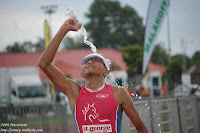Many of endurance endeavors especially inexperience athlete, lack of knowledge and practice about hydration status during their race. As a result, many 'young athletes' suffered a dehydration and the worst is heat stroke when the race goes beyond 4 hours. A great knowledge and good practice of this input can change many endurance athletes performance and their days!
The fundamental purpose of the cardiovascular system is the efficient circulation of blood. When the blood is transported to the body's organs and muscles efficiently, the body is equipped to utilize its energy stores and nutrients in an optimal fashion. As plasma, the fluid component of blood, is itself over 90% water, the proper replacement of fluids into the body during exercise is a essential.
All athletic activities have a common feature that, in varying degrees, places an additional stress upon the body: the requirement of the additional generation of energy. Energy to power the movement of the body and its structures is demanded, either in a freestanding mode, in such sports as such as running, gymnastics, or wrestling, or when the athlete is propelling an object, as in bobsledding, canoeing, or cycling.
The body possesses two main energy systems, the aerobic and the anaerobic systems. The anaerobic system comprises two separate mechanisms, the alactic and the lactic processes. Both processes rely on the ultimate production of the compound adenosine triphosphate (ATP), which is produced through the metabolism of the body's stores of glucose. The nature of the activity will determine whether the aerobic energy system, or one of the two anaerobic systems will produce ATP from the available glucose reserves.
Seventy-five percent of the energy generated through the metabolism of glucose is released from the body as heat. The remaining 25% of the energy is directed to muscular contraction and the other aspects of human function and movement. The heat produced through metabolism is very dangerous to the body, and it must not be allowed to build up. The mass of the athlete is also a significant factor in determining the impact of the generation of heat. As a general rule, the larger the athlete, the greater the amount of heat that will be produced, and the greater the prospective impact on the cardiovascular system.
Heat dissipates from the body through the evaporation of sweat from the surface of the skin. In endurance sports, the replacement of these fluids is essential to performance. In sports such as marathon running, long distance cycling, and cross-country skiing, a rule of thumb regarding fluid replacement suggests that the athlete, in the course of the activity, consume between 6.7 oz and 27 oz (200-800 ml) of fluid per hour of competition.


Like most human systems, optimal function of the cardiovascular system will follow optimal fluid levels within the vascular network. The thirst sensation is a very poor indicator that the athlete has a lower-than-optimum level of hydration; an athlete may have a deficiency of 1 qt (1.0 l) or more before actually feeling thirsty. Where the system begins to become dehydrated, the blood plasma will correspondingly become reduced in volume, creating two important consequences: reduced ability of the blood to transport oxygen and nutrients and reduced ability of the blood to dissipate heat.
The result of dehydration to the cardiovascular system may have three progressive consequences for the athlete: heat cramps, heat exhaustion, or heat stroke. Heat cramps are a condition in which the body becomes dehydrated and the blood system is not able to efficiently deliver electrolytes (salts, such as sodium and potassium), essential to muscle function. Heat exhaustion is a more serious condition, in which the athlete becomes disabled due to the inability to dissipate heat, often resulting in elevated heart rate and lethargy. Heat stroke is an incapacitating heat illness, in which the body begins to shut down some of its process; body temperature frequently exceeds 105°F (40°C), and the athlete is often not coherent. Heat stroke is fatal unless the athlete receives immediate medical attention.
Proper hydration is not the only factor that will impact upon the proper function of the cardiovascular system during exercise. Related to fluid intake are environmental issues such as heat, humidity, and presence of wind, as well as the rate or intensity of energy expenditure. When an athlete becomes dehydrated, the ingestion of fluids to correct the shortage will not have an instantaneous effect on blood fluid. The water or similar liquid must be digested and passed through to the small intestine, a process that usually takes a number of minutes to achieve a physiological result. For this reason, athletes in endurance events will consume fluids well before they expect to feel a thirst sensation.
Just as too little fluid replacement will cause significant circulatory problems, an athlete cannot guarantee proper cardiovascular function simply through constant fluid intake. When an athlete is exposed to high temperature conditions, and excessive amounts of fluids are consumed, the athlete may be subjected to a condition known as hyponatrania. Too much fluid will dilute the proportion of important salts such as sodium in the bloodstream. When coupled with the natural loss of sodium through sweat, the loss of this important electrolyte may interfere with the functions of the brain, heart, and muscles, leading to apathy, confusion, and nausea.
As the bottom line, as we put our cardio at optimum pace, the replacement of quality fluid must be take seriously. As we need to achieve the race objective, but at the same time our cardiovascular must be pampered nicely and wisely.


No comments:
Post a Comment